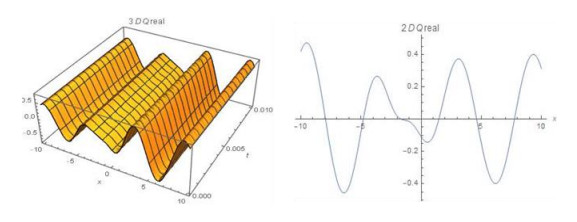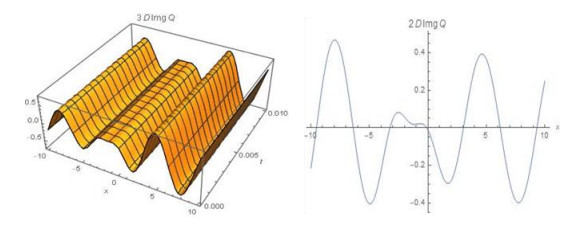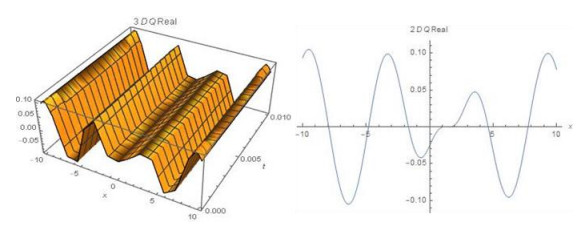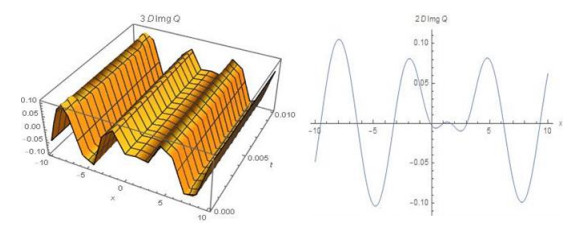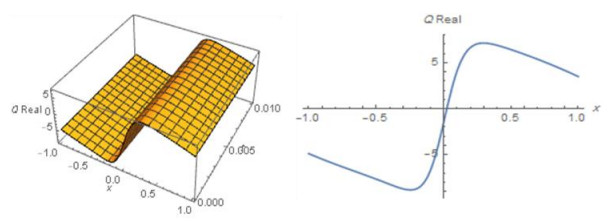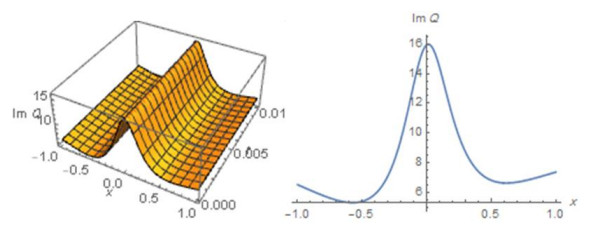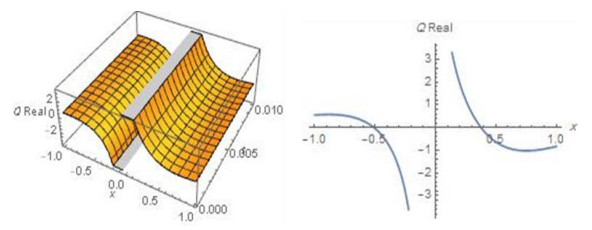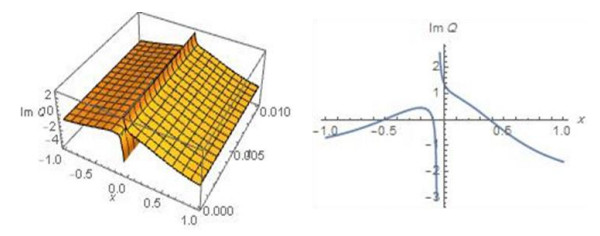| Sunflower |
Plants |
The plants were watered with three different salinity levels which had electrical conductivities (ECs) of 0.7, 4 and 8 dS/m. The salinity of tap water is represented by the electrical conductivity's lower limit. Two magnetic intensities, 1000 and 3000 Gauss, were applied to the irrigation water treatment apparatus. |
The salinity of untreated water has a significant negative impact on sunflower development. Irrigation with magnetized water (MW) can mitigate the negative impact of saline water and enhance sunflower growth. Depending on several factors (such as the part of the plant, the EC of water and the strength of magnetic field), magnetizing saline water can increase the root depth, germination, stem height and wet weight of the green part and root part of the sunflower plants. |
[1] |
| Iceberg lettuce With two varieties: lemur iceberg lettuce and 077 iceberg lettuce |
Plants |
Four kinds of irrigation water were applied: ordinary irrigation water (IW1, EC = 0.96 dS/m), magnetized irrigation water (IW2, EC = 0.96 dS/m), saline water (IW3, EC = 4.56 dS/m) and magnetized saline water (IW4, EC = 4.56 dS/m). Three depletion ratios (DR) of field capacity (FC) (DR0 = 50%, DR1 = 60% and DR2 = 70%) and three slopes of hydroponic pipes (S1 = 0.0%, S2 = 0.025% and S3 = 0.075%). |
Both varieties of iceberg lettuce had higher water productivity, total soluble solids and fresh weights after irrigation water had been magnetized. With the combinations of IW3DR2S3 and IW4DR1S3, both varieties recorded the highest fresh weight (3.10 kg/m) and water productivity values (39.15 kg/m3). The combination of IW4DR1S3 yielded the maximum fresh weight (2.93 kg/m) and water productivity (36.15 kg/m3) for iceberg lettuce 077. Saline irrigation of lettuce without magnetic treatment decreased its fresh yield by a factor of between 55% and 60%. While using normal water, the magnetic treatment had no effect on the weight of the lettuce when it was fresh. |
[4] |
| Dry broad bean |
Seeds and plants |
Three magnetic treatments were used: magnetically treated seeds (MTS), magnetically treated irrigation water (MTIW) and no magnetic treatment of either the seeds or the irrigation water. Dry broad bean seeds were subjected to a 165-mT electromagnet-induced magnetic field for 2 and 4 min. A 165-mT magnetic field was applied to irrigation water. |
Two-minute MTS and MTIW significantly increased plant growth and yield in broad bean plants. Compared to the control plants, the pods of the 2-min MTS and MTIW emerged 6 days earlier, whereas the pods of the 4-min MTS and MTIW emerged 5 days later. The quantity of seeds was the parameter most impacted, increasing by 21% for the 2-min MTS and MTIW in comparison to the control. |
[8] |
| Maize |
Plants |
A brown coal and magnetization of Cu-contaminated water were applied to maize plants. |
Water contaminated with copper sulfate or nitrate significantly increased shoot dry matter (distilled water) as compared to the control, which was irrigated with distilled water. MW caused significant increases in the concentration of Cu in plant tissues and phytoextraction efficiency (PE) of copper sulfate. On the other hand, the MW decreased the translocation efficiency, translocation factor and yield biomass of maize plants. |
[12] |
| Barley (Hordeum vulgare L.) |
Seeds and plants |
At the center of magnets with variable gaps, the plates containing seeds were positioned vertically. Each magnet yielded 14–20, 32–42, 110–130 or 240–250 mT values. Two flat pole pieces (8 × 4.5 cm) were attached to each pole of the magnets to create a consistent magnetic field around the seeds. |
Germination was enhanced by magnetic field treatment at lower strengths (≤125 mT). Cell membranes in roots were destroyed by the magnetic field, which can change the tissue's elemental composition. The concentration of macroelements (Ca, Mg, P and K) gradually decreased as the magnetic field strength increased, whereas the contents of microelements (Fe, B, Cu, Mn, Zn and Mo) increased in the roots. It appears that the magnetic moments' direction may have been affected by the magnetic field treatment at greater strengths (250 mT). Magnetic field application can improve germination, photosynthetic machinery and growth, as well as modify nutrient uptake and abundance in tissues. |
[20] |
| Lettuce (Lactuca sativa L.) |
Seeds and plants |
The nutrient solution and water passed through magnetic fields. Lettuce seeds were divided into two groups and germinated under the effect of magnetized and non-magnetized water. The circulating hydroponic method was then used to cultivate each sprout group that was obtained from each water system by using magnetic and non-magnetized nutrient solutions. |
The rate of seed germination was enhanced by the MW. The fresh weight (45.57%), dry weight (34.16%) and plant height (47.44%) were positively affected under the effect of the magnetized nutritional solution. The magnetized nutrient solution increased the quantity of chlorophyll a (16.43%) and b (26.30%), elements (such as N, Ca, P, K, Mg, etc.), vitamin C (2.87%) and carotenoid (13.01%). |
[24] |
| Calendula officinalis |
Plants |
Two different types of soil additives (Fe2SO4 and peat moss) and three different types of water (tap water (TW), well water and magnetized well water) were used. |
Saline well water had a negative impact on plant growth and flowering as compared to using TW. Plants irrigated with the MW exhibited a considerable improvement in all vegetative and blooming growth indices. Additionally, plants irrigated with the MW had higher mineral contents and higher survival rates than plants irrigated with TW. The levels of Na+ and Cl− in plant leaves were much lower after irrigation with the MW, demonstrating the significance of magnetization in reducing the negative effects of salinity. |
[25] |
| Festuca arundinacea |
Leaves |
The amount of water was adjusted in accordance with the moisture of the soil. MW was prepared using a 20–2000mT electromagnetic field generator. |
Both types of irrigation water caused plants to accumulate more Cd in their dead and senescent leaves than in other plant tissues. Senescent and dead leaf biomass increased after irrigation with MW, and a substantial amount of Cd (23.6%) was redistributed into dead leaves compared to the control. More Cd was removed from plants irrigated with MW by collecting their dead and senescent leaves. Magnetic fields were shown to lower the cost of disposing of harvested residue while increasing the phytoremediation efficacy of plants for Cd. |
[26] |
| Celosia argentea |
Seedlings |
The seedlings received 3-day irrigation of double-deionized or MW during the cultivation process. The MW was created using a PEM-5005 P electromagnetic device, which has a 20–2000-mT magnetic field. |
Root pruning increased the effectiveness of plants in phytoremediation, and this impact was improved when combined with irrigation with MW. |
[27] |
| Barley (Hordeum vulgare L.; cv Giza-128) |
Plants |
Two factors were applied in the experiment: (1) water treatments (MW and non-magnetized water) and (2) five levels of salinity stress (320, 2000, 4000, 6000 and 8000 ppm). MW was prepared by passing water through a static magnetic field (0.35 T). |
Irrigation of barley plants with magnetized saline water reduced the detrimental effects of salinity stress, increasing the grain yield by 14.75, 14.32, 16.06, 12.97 and 15.85% under 320-, 2000-, 4000-, 6000- and 8000-ppm salinity levels, respectively. Magnetized saline irrigation water boosted photosynthetic pigments and growth indices, even at high salinities, as compared to irrigation with non-magnetized saline water. |
[43] |
| Festuca arundinacea |
Seedlings |
Two treatments were applied: MW and non-magnetized water. |
MW alleviated oxidative damage, decreased the excreted Fe amount and increased the Cd excretion ability of F. arundinacea. |
[44] |
| ‘Taifi’ pomegranate (Punica granatum L.) |
Shrubs |
Water was subjected to a magnetic field device (strength = 14,500 Gauss and diameter = 2 in) |
Enhanced chlorophyll content and nutritional status, decreased proline content, improved vegetative growth with minimum consumptive water use, promoted optimum water-use efficiency and reduced soil salinity. |
[45] |
| Chickpea (Cicer arietinum L.) |
Seeds and plants |
Tubes surrounded by locally manufactured magnets with different overflows (0.2, 0.15 and 0.1 T). |
MW increased the protein content in seeds and enhanced the contents of nitrogen, phosphorus, calcium and potassium in the leaves and seeds. |
[46] |
| Corn |
Seeds |
Corn seeds were exposed to four irrigation treatments with MW, namely, magnetic induction of 0.28 T (T1), 0.229 T (T2), 0.029 T (T3) and 0 T (control). |
The various percentages of germination in corn seeds were significantly influenced by the different magnetic induction conditions applied via seed treatment and irrigation water. No significant effect among the three treatments (T1, T2, T3) was observed on germination time, fresh mass, dry mass or seedling vigor. |
[47] |
| Balkız bean (Phaseolus vulgaris) |
Seeds and plants |
Irrigation treatments were magnetized and non-magnetized, and water salinities were 0.38, 1.5, 4.5 and 7.0 dS/m−1 |
Irrigation plants with MW had increased fresh yield (21.35%), water-use efficiency (23.00%) and irrigation water-use efficiency (14.8%) as compared to the non-magnetized water-treated plants. Saturated soil salinity was decreased by 20%. The green leaf area (13.4%), stomata (23.9%) and leaf succulence (3.3%) increased in the MW-treated plants as compared to the non-treated plants. Additionally, under magnetized saline water conditions, bean crops showed a capacity to defend water in tissue against salinity toxicity up to a 5.24 dS/m soil salinity level. |
[48] |
| Tabasco pepper |
Plants |
The MW was prepared using a Quantum Biotek magnet, which produces a changeable magnetic field (0 to 156 mT). The MW was circulated five times through the magnet at a flow rate of 10 L/min. The irrigation levels were settled to 100% and 50% of FC. According to the kind of water and the amount of irrigation, it produced four treatments: MW at 100% FC (MTW100), MW at 50% FC (MTW50), control water at 100% FC (CON100) and control water at 50% FC (CON50). |
At both irrigation levels, the fruit yield of plants watered with the MW exhibited a non-significant increase, whereas large- and medium-sized effects were found for the dry weight and fruits per plant. Quantum yield was the only photosynthetic measure to show a significant increase, despite increases in net assimilation and stomatal conductance of 17% and 28%, respectively. However, interestingly, the relative water content and electrolyte leakage in leaves were not significantly impacted at 50% FC. |
[49] |
| Green pea (Pisum sativum L.) |
Plants |
Four treatments were used: full irrigation (FI) with non-magnetized water (W1) and three different irrigation levels (I1 = 100%, I2 = 80%, and I3 = 60%) with MW (W2). |
A good technique to increase green pea plant yield, enhance quality traits and improve water-use efficiency is through irrigation with MW. |
[50] |
| Cotton (Gossypium hirsutum L.) |
Seeds and plants |
An external permanent magnetizer of the CHQ type was used to prepare MW using two types of water: fresh and brackish. It was built of sintered Rufe-B and had an 8 × 10 cm2 magnetic field with a 300-mT magnetic field strength. The magnetic time was set to 30 min while the water flow rate was 14.7 L/min when making MW. |
Irrigation with magnetized fresh and magnetized brackish water increased the germination rates of cotton seeds by 13.14% and 41.86%, respectively. When cotton was irrigated with MW instead of non-MW, the stomatal limit value decreased and the net photosynthetic rate, transpiration rate, and instantaneous water usage efficiency were significantly enhanced. Under the condition of the magnetized brackish water, cotton had stronger effects on photosynthesis and water-use efficiency than under the magnetized freshwater condition. |
[51] |
| Rice and wheat |
Seedlings |
Plants were irrigated with three types of activated water: magnetized distilled water, aerated distilled water and magnetized aerated distilled water with a total of four treatments for each species. |
When wheat plants were irrigated with MW irrigation, their total root volume and root length increased by 7.7–8.6% and 17.2%, respectively. This resulted in a notable 13.6% increase in aboveground dry biomass. The growth of rice seedlings and roots was also enhanced by irrigation with MW and magnetized aerated water. The growth of wheat seedlings and roots, however, was inhibited by irrigation with magnetized aerated water. |
[52] |
| Wheat |
Plants |
There were three different irrigation rates: 80% of the FC, 65% of the FC and 50% of the FC. TW, MW, oxygenated water (OW) and magnetized and oxygenated water (M&OW) were the four different forms of irrigation water. Tap water was magnetized repeatedly using a 3000-Gs magnetic field (magnetic ring, 3.0-cm inner diameter, 3.4-cm outer diameter, 3.2-cm height) to create MW. |
Under various irrigation regimes, activated water enhanced wheat growth. The plant height, leaf area, aboveground biomass, special product analysis division (SPAD) value and photosynthetic indicators increased. With varying levels of irrigation, the yield and water usage efficiency changed. MW and OW outperformed TW in terms of yield and water usage efficiency at 80% FC. MW, OW and M&OW had a greater yield and water usage efficiency than TW with 65% FC. OW and M&OW exhibited noticeably greater yield and water usage efficiency than TW at 50% FC. |
[53] |
| Sweet basil (Ocimum basilicum L.) |
Plants |
Arbuscular mycorrhizal fungi, magnetic solution and phosphorus concentrations of 0, 5, 10, 20 and 40 mg/L were used. |
Both the magnetic solutions and arbuscular mycorrhizal fungi impacted the basil plant's growth, the shoots' nitrate content and the rhizosphere conditions. |
[54] |
| Beta vulgaris L. |
Plants |
Two treatments were applied, including MW and non-MW treatments (Control, C). The MW was prepared by using a magnetic device (0.8–0.9 T). |
Magnetic treatment caused increases in the dissolution of salts and EC in the water of the irrigated soil. Ca2+ (16.6%), K+ (9.7%) and Na+ (13.4%) contents in the MW-irrigated soil were decreased. The concentrations of Na+ (4.91%) and Fe2+ (126.3%) ions in the roots and leaves were increased in the plants irrigated with MW. The plants irrigated with MW had higher weights for the fresh leaf, dried leaf and root. |
[55] |
| Populus × euramerican ‘Neva’ |
Seedlings |
Treatment of Cd(NO3)2 solutions (at 0 and 100 mML−1) involved the application of a magnetic device with a 300-Gs field strength. |
Under Cd stress, magnetization can enhance seedling growth and speed up the production of photosynthetic pigments at a concentration of 100 µmol·L−1. Additionally, it might support root growth, which was advantageous for the uptake and transfer of the mineral nutrient components. The activity of nitrate reductase and nitrite reductase in leaves was stimulated by tolerance to Cd, which appeared to lower the amount of nitrite present; otherwise, the accumulation of NH4+ in roots could provide an abundance of raw materials for the synthesis of amino acids triggered by irrigation with magnetically treated water. By promoting glutamine synthetase (GS) and glutamate synthase (GOGAT) activity, the magnetization's stimulation of the GS-GOGAT cycle may increase the effectiveness of nitrogen metabolism. |
[56] |
| Strawberries |
Plants |
Four treatments were applied: (1) magnetic water level 1 = 3800 Gauss, (2) magnetic water level 2 = 5250 Gauss, (3) magnetic water level 3 (MWL 3) = 6300 Gauss and (4) normal water. Treatments of plants were in combination with three soilless culture systems (a nutrient film technique (NFT) hydroponics, tower aeroponics and pyramidal aeroponics). |
The combination of the NFT system and MWL 3 produced the most leaves, the highest stem diameter and the largest leaf area in the strawberry plants when compared to the control. This combination outperformed all other treatments in terms of fruit yield, quality and other factors like titratable acidity, total soluble solids and fruit hardness. |
[57] |
| Wheat (Triticum Aestivum L.) with three cultivars (Aksad 901, Karem and Gamina) |
Seeds and plants |
The magnetic treatment involved subjecting the seeds to various periods of magnetization (0, 15, 30 and 45 min) and the passing of seawater levels (0, 20, 50 and 80%) through a magnetic field (14500 Gauss or 1.45 T). |
When compared to the three untreated wheat cultivars, either the magnetically stimulated seeds or irrigation with magnetized saltwater performed better. Magnetized irrigation water had no effect on the seed germination rate, but magnetic pre-sowing seed treatment increased the seed germination rate, especially under the conditions of 80% salinity and 45 min, compared to untreated seeds. |
[58] |
| Date palm Hayany |
Plants |
Four levels of K-Humate and two kinds of water irrigation were used. MW was prepared by passing water through a field using a Magnolith permanently with a strength ranging between 2000–4000 Gauss. |
Higher yield and bunch weight were obtained by treatment of K–Humate at 300 g/tree with magnetic water irrigation. In both seasons, this treatment resulted in the highest fruit weight, flesh weight, size and dimensions. By applying K-Humate and magnetic water irrigation, the total soluble solids, reducing sugar and nonreducing sugar contents in the fruits also increased. As compared to the control and other treatments, this treatment produced the highest values for the contents of N, P, K, Ca and Mg. |
[59] |
| Maize cv. Maxima |
Plants |
The kind of irrigation water at two levels (crossed and without passing through a magnetic field) and the tape drip irrigation system at two levels (looping and no looping) were used as experimental treatments (looping and no looping). A magnetic field was produced using tube wires, an AC-to-DC converter and a looping arrangement made of three-way tubes. |
MW increased the system's average discharge by 4.2% and reduced its coefficient of variation by 0.98%. Magnetic water irrigation increased the fresh weight (9%), water-use efficiency (9.5%), dry weight (1.4%) and leaf area (17%) as compared to irrigation with to non-MW. |
[60] |
| Soybean |
Seeds and plants |
The major two factors (F1) were plots that had been bio-fertilized and those that had not. Three application rates (50%, 75% and 100%) of the three N, P and K fertilizers were the sub-factors (F2). Seeds that had been magnetically treated and those that had not been treated (NM) were the sub-sub-factors (F3). All factors were investigated for dry soybean seeds without soaking and soaking seeds in MW. |
The soybean seed yield increased by 49.98% for the bio-fertilized magnetized seeds at 75% and 100% mineral N-P-K fertilization as compared to NM soaked seeds at 50% N-P-K without bio-fertilization. The protein increased by 41.69% after the 75% mineral fertilization, whereas the proline decreased by 46.68%. Before planting, treated seeds with the magnetic field and combined bio/mineral N-P-K fertilization decreased the proline that mitigates the stress conditions. |
[61] |
| Sunflower (Helianthus annuus L.) |
Plants |
Along with three other salinity irrigation treatments, there were two separate magnetic (W1) and non-magnetic (W2) irrigation water treatments. |
The effects of the W1 and W2 irrigation waters on stem height, stem diameter, head diameter and leaf fresh mass were significantly different. After irrigation with magnetic water, sunflower production (4064 kg/ha) increased. Additionally, salinity decreased grain yield. The productivity and effectiveness of irrigation water can be improved by irrigating with saline water that has been exposed to a magnetic field. |
[62] |
| Artichoke (Cynara scolymus L.) |
Plants |
There were four levels of electromagnetic field intensity in the experimental treatments (0, 3000, 6000 and 10000 Gauss) |
Irrigation with MW had a substantial impact on plant development, shoot weight, root weight, the efficiency of water consumption and chemical compounds. In samples that were irrigated with water magnified with 6000G, the maximum phenol concentration (3.99 mg/g) and antioxidant activity (66.74%) of plant extract were found. |
[63] |
| Spinach (Spinacias Oleracea L.) |
Plants |
The spinach was irrigated using a surface drip irrigation system with three levels of irrigation water salinity (SL1=1.21, SL2=2.98 and SL3=4.54 dS/m), as well as four irrigation water stresses (IR100%, IR85%, IR70% and IR55%) under magnetic water treatment and non-magnetic water treatment. |
The application of treatment SL1 and IR100% under the condition of MW for both seasons produced the greatest values for the yield and quality of spinach leaves. When treatment was applied at SL1 and IR55% with MW, the seasonal actual evapotranspiration of leaves was the lowest for both seasons. The application of treatment SL1 and IR70% with MW resulted in the greatest values for spinach leaf irrigation water-use efficiency and water-use efficiency. |
[64] |
| Cowpea (Vigna unguiculata L. Walp.) |
Plants |
There were two treatment regimes: the first regime was irrigated with MW and the second regime was irrigated with non-MW. |
The shoot height, number of leaves, leaf area and internode length of cowpea plants were enhanced with the use of MW. Plants treated with MW had significantly higher growth indices (net assimilation rate, crop growth rate, leaf area ratio, root-to-shoot ratio and tissue water content) than the plants in the control group. Biochemical parameters such as photosynthetic pigments and parameters related to the yield (number of fruits, seeds in pods and seed weight) were also significantly higher in plants treated with MW as compared to plants treated with TW. |
[65] |
| Chickpea (Cicer arietinum L.) |
Seeds and plants |
Three tubes encircled by magnets with different overflows (0.2, 0.15, 0.1 T) were used to prepare MW. A 100-kg treatment of chemical fertilizer was applied to the soil in planting lines. |
A significant effect of fertilizing and magnetization was observed on the height of plants, nutrient contents, the number of pods and dry vegetative weight as compared with the control. |
[66] |
| Potato |
Plants |
There were two types of treatments: MW and normal water. To prepare the MW, a magnet device and an electromagnetic device were inserted together in the water's passage. |
The total yield of potatoes treated with MW (25.4 tons per hectare) was higher than that of the potatoes treated with non-MW (19.4 tons per hectare). Magnetizing saline water significantly increased the size and weight of tubers, germination, yield, quality, freshness and the number of tubers per plant, as well as the reduction of weeds and crop pests. |
[67] |
| Wheat (Triticum aestivum L.) Cultivar IPA 99 |
Seedlings |
Two salinity levels of water were used to irrigate the plants and the water was magnetized using a magnetron (4000 Gauss). There were four types of treatments: M1 (plants irrigation with saline magnetize water; EC= 1.83 ds/m), M2 (plants irrigation with saline water; EC=2.728 ds/m), M3 (plants irrigation with saline magnetize water; EC=2.8ds/m), and M4 (plants irrigation with saline water; EC=3.17ds/m). |
The magnetization of saline water decreased its harmful effects on plants. Superoxide dismutase, catalase and peroxidase enzyme levels increased for the magnetized saline water by 85%, 65% and 34%, respectively. The morphological features of the plants irrigated with magnetized saline water improved in terms of the thickness of mesophyll tissue, epidermal, leaf and vascular bundles. |
[68] |
| Mentha piperita |
Plants |
The water was magnetized using alternating magnetic fields (M1: control, M2: 100 mT, M3: 200 mT and M4: 300 mT) and different salinity levels (S1: control, S2: 40 mM NaCl, S3: 80 mM NaCl and S4: 120 mM NaCl). The growth mediums were as follows: X1: coco peat, X2: palm, X3: coco peat + perlite and X4: palm + perlite. |
At the greatest salinity levels, the application of magnetic treatments, particularly at the 100- and 200-mT levels, significantly increased plant concentrations of N (1.08%, S3M4X1), P (0.89%, S3M3X1), K (3.23%, S3M3X1), Ca (53.6 mg/kg, S4M4X4) and Mg (39.63 mg/kg, S3M3X2) compared to plants in the non-magnetized group. Under salt stress, MW increased the concentration of Fe and Zn in the plants. The MW may be more successful at reducing salt stress if combined with the organic and mineral media, as it improves nutrient uptake. |
[69] |
| Eggplant (Solanum Mebongena L) |
Seeds and plants |
Three magnetized intensities were used (M0=0 Gs, M1=600 Gs, M2=1200 Gs) and two levels of bio-fertilization: level 1 (without bio-fertilizer) and level 2 (with bio-fertilizer). |
The MW-treated plants had a significant increase in the length of the plant and yield characteristics. All growth characteristics were significantly impacted by the binary interference between MW and bio-fertilization. |
[70] |
| Radish |
Plants |
Three treatments were applied: distilled water (control), distilled water magnetized for 30 min and distilled water magnetized for 1 h. The field intensity of the magnets was 0.6 T. |
Magnetizing water for 1 h caused an increase in the tuber circumference (46%), leaf area (29%), fresh weight of shoot (19%), chlorophyll a (46%), carotenoid (43%), dry weight of the tuber (82%) and fresh weight of tubers (100%). The best treatment was the 1-h MW treatment. |
[71] |
| Winter wheat |
Plants |
A tank for holding water, a pump, an exit pipe and a magnet make-up system were used to magnetize water. A permanent magnet with a 3000-G field intensity was used. To magnetize the water, the water was passed through the pipe where the permanent magnet was positioned on the pipe's outer wall. The eight irrigation treatments were: no irrigation, 0 mm; pure groundwater irrigation with a total irrigation amount of 180 mm; MW irrigation with total irrigation amounts of 60, 120 and 180 mm, respectively; and GD1, GD2 and GD3 (ionized water irrigation). |
When compared to pure groundwater, MW had a 10.1% higher grain yield at 120 mm. The MW had the highest water-use efficiency for 120 mm at 28.0 kg ha−1mm−1. For irrigation using MW, water-use efficiency at 120 mm was 22.3 kg ha−1 mm−1, i.e., 8.8% more than with pure groundwater. MW irrigation can enhance the growth, total yield and water-use effectiveness of wheat plants. |
[72] |
| Velvet bean (Mucuns pruriens) |
Seeds and plants |
The structured water was produced by a bespoke water generator (a closed-loop water system) using two energy fields (magnetic and UV radiation). The treatments were as follows: magnetized seed, MW and water treated with a hydroxylated water generator. Three soil moisture levels were applied to the velvet bean plants. |
Under conditions of low soil moisture, the combination of magnetic seed and structured water treatments increased water savings from 32 to 52% over the unstructured water treatments. The combined seed and water treatments significantly reduced irrigation water use by altering how drought-adapted plants respond to water stress circumstances. |
[73] |
| Winter wheat |
Seeds and plants |
Winter wheat was grown hydroponically with the following treatments: a control group, oxidation, magnetization and a combination of magnetization and oxidation. |
Plants watered with oxidized water (along with oxidized and subsequently magnetized water) displayed better grain yields and water-use efficiency than control plants under identical irrigation levels. Additionally, plants irrigated with magnetized and/or oxidized water showed significant increases in root vigor, root length density, root weight density and root surface area density. Cultivation with magnetized and/or oxidized water encourages root growth and increases the chlorophyll content of leaves and root/shoot ratio. Additionally, the plant's root vigor was enhanced by the magnetic and/or oxidation treatment of brackish water, which should have a positive effect on crop yield. |
[74] |
| Jojoba (Simmondsia chinensis) |
Seedlings |
Four treatments were used: magnetized normal water (NW = 2.11 DSm−1) and different concentrations of Red Sea water (RSWC1 = 5.61 DSm−1 and RSWC2 = 7.01 DSm−1). MW was prepared using a magnetic field of 180 mT. |
All magnetized concentrations of saline water exhibited significant enhancements in all characteristics compared with the controls, except membrane damage, proline and germination rate. Compared to RSWC1 and RSWC2, the response of all features was more substantial for the NW. |
[75] |
| Raphanus sativus L. |
Seeds and plants |
Ten R. sativus seeds were put in petri dishes with Whatman No. 1 filter paper layered in two layers. The petri dishes were filled with 3 ml of water. Then, 3 ml of the treated liquid was added to each plate. Exactly the same amount of magnetic water was added to each petri dish. |
The highest plant height, stem length, root length and fresh and dry weights of root and shoot systems were found in plants that were irrigated with MW. Raphanus sativus grown with MW had improved physical soil characteristics compared to the control. |
[76] |
| Tobacco (Nicotiana tabacum var. Turkish) |
Plants |
In a hydroponic experiment, four magnetic treatments were used: distilled water, magnetized distilled water, TW and magnetized TW. The intensity of the magnetic field was about 0.07 T. |
Shoot height and root length significantly increased in plants that were irrigated with magnetized distilled water. The photosynthetic rate and protein content followed the same trends; however, there were no significant differences in the stomatal conductance or transpiration rate. In contrast, plants that were irrigated with TW showed a substantial increase in total carbohydrates. Plants irrigated with TW and magnetized TW had distorted chloroplasts and damaged thylakoid membranes linked with plastoglobules. |
[77] |
| Wheat, barley and lentil |
Seeds and plants |
Seeds of wheat (Triticum aestivum), barley (Hordeum vulgare), trigonella (Trigonella foenum-graecum) and lentil (Lens culinaris M) plants were treated with fresh water (control), magnetized low-saline water and non-magnetized low-saline water. |
When seeds were treated with MW, their water absorption rates were higher than those treated with non-MW. When compared to the control treatment, treating plant seeds with MW during germination improved the germination, seedling length, fresh weight, dry weight, vigor index and biomass accumulation in the wheat, barley, trigonella and lentil plants. |
[78] |
| Grape (Vitis vinifera × V. labrusca cv. Summer Black) |
Plants |
Four treatments were applied: MW irrigation treatment (M0), non-MW irrigation (NM0), magnetized nitrogen (MN) and non-magnetized nitrogen (NMN). |
MN had a marked impact on the ratio of root to crown, as well as on the biomass of the leaves, roots and whole plants as compared with NMN. In the MN treatments, a significant increase was observed in the stomatal conductance, pigment content of leaves, actual photochemical efficiency, photochemical quenching coefficient and net photosynthetic rate. In the contrast, intercellular CO2 concentration, non-photochemical quenching coefficient, non-photochemical dissipation and excitation pressure were significantly decreased. |
[79] |
| Winter wheat |
Seeds and plants |
The magnetic field was produced by using an electromagnet with an intensity of 0.2 T. Three treatments were applied: T1 (magnetized seeds + MW), T2 (normal seeds + MW) and T3 (normal seeds + non-MW). |
MW boosted the growth of wheat and increased water-use efficiency, yield, plant height and leaf area index with different levels. Increases were also found in the effective panicle number, spikelet number and rate of the grain yield of the T1 and T2 treatments compared with the T3 control treatment. |
[80] |
| Moringa (Moringa oleifera and Moringa peregrina) |
Plants |
Three irrigation regimes were applied: 100%, 50% and 20% FC and two water treatments (normal water and MW). The water was magnetized using a magnetic device with 30 mT of strength. |
The physiological traits and growth parameters of the Moringa species were significantly impacted by drought stress. MW helped to mitigate the negative impacts of drought stress, the Fv/Fm ratio, chlorophyll content, leaf gas exchange and ion levels. |
[81] |
| Tomato |
Seeds and plants |
Water was flowed through a magnetic flux density of 319 Gauss while tomato seeds were placed on a permanent magnet (1000 Gauss) for 24 h. There were four treatments: T1 [magnetized seed (MS) and MW (T1)], T2 [non-MS (NMS) and MW], T3 [MS and non-MW)] and T3 [NMS and non-MW]. |
Tomato yield increased by 27% when NMS and MW were combined relative to the 44% when the magnetized seed and water were combined. MW had more influence on tomato yield than just magnetizing the seed and irrigating with non-MW. All heavy metal concentrations in the tomato were within FAO/WHO permitted levels, and MW did not introduce any heavy metals that would be detrimental to humans. |
[82] |
| Nitraria, Haloxylon and Atriplex |
Plants |
Plants were irrigated with two types of water: non-MW and MW. |
Species irrigated with MW performed better on the growth metrics that were measured. The three species irrigated with MW showed increases in the leaf development of 121.74 (19.59%), leaf area index of 108.97 (17.5%) mm2, special leaf area of 8.68%, relative water content of 9.81% and SPAD of 14.77% compared to plants irrigated with normal water. |
[83] |
| Wheat |
Seeds and plants |
Magnetic fields (400, 500 and 600 mT) and different types of water (distilled and saline water) were applied to wheat plants. |
Wheat seed germination and growth characteristics were significantly impacted by the strength of the magnetic field and the type of treated water. The morphological characteristics of the treated plants were improved. Groundwater-treated control seeds had a germination rate of 20%, while 400-mT-treated seeds had a germination rate of 53.3%. The root lengths that were impacted by distilled water in the 400-mT field and control groundwater were 155.3 and 20.0 mm, respectively. The amount of treated distilled water with a 600-mT magnetic field per kilogram of seedling fresh weight was the highest. |
[84] |
| Parsley (Petroselinum Crispum) |
Plants |
Four different MW treatments were applied. The MW was passed through a magnetic funnel, once, three times, four times and six times compared with the TW as a control. |
Parsley irrigated with MW showed an increase in germination, plant height, number of leaves, leaf area, chlorophyll content and certain components (K, Ca, Mg) as compared with the control. The outcomes showed that MW can be a potential method for a high parsley yield. |
[85] |
| Spinach Matador (Spinacia Oleracea L) |
Plants |
Two salinity levels were used in the pot experiment: 0.2 g/L (TW) and 2.2 g/L (TW plus NaCl). A 13.5-mT magnetic treatment device was used to treat the irrigation waters. |
With MW, the relative growth rate increased in response to irrigation, reaching 6.9% and 28.8% higher levels than the control salinity levels of 0.2 g/L and 2.2 g/L, respectively. In terms of the characteristics of the soil after harvest, irrigation with magnetized fluids raised the EC and moisture while decreasing the pH. In comparison to the soil at T0, the concentrations of all key elements (Ca, Na, Mg, K, Cl) were higher in the pots irrigated with magnetized fluids. The magnetic treatment increased the soil's ability to replace calcium with sodium by using 2.2 g/L of salty water. |
[86] |
| Wheat (Triticum aestivum) (Three varieties: Sakha-94, Maser-2 and Gemiza-11) |
Plants |
In this study, there were two factors: 1) three water treatments for irrigating with brackish water, magnetized brackish water (BW 1) and magnetized brackish water (BW 2), along with three wheat varieties (Sakha-94, Maser-2 and Gemiza-11). |
In all evaluated vegetative development parameters at 75 DAS (i.e., plant height, fresh and dry weight of wheat shoot, water contents and flag leaf area), irrigation with magnetically treated BW1 or magnetically treated BW2 surpassed irrigation with brackish wheat cultivars. The most significant crop yield was raised by irrigation using magnetic water. |
[87] |
| Melon (Cucumis melo L.) |
Plants |
A total of two factors were used: the first involved two types of fertilizer treatment (urea 50 kg·N·ha−1) with bio-fertilizer (Azospirillum brasilense and Azotobacter chroococcum) and chemical fertilizer (urea 100 kg·N·ha−1), and the second involved MW and non-MW. |
When compared to non-MW, MW showed considerable superiority in all study trait rates. The highest values of all study traits were found in the treatments that combined bio- and chemical fertilizers with MW, including the fruit yield (7.2 kg·plant−1), fruit weight (3.4 kg·replicate−1), total yield (28520.0 kg·ha−1), fruit length (27.6 cm), fructose sugar content in fruits after 24 days of storage (13.1%), fruit diameter from the outside and inside (16.8 and 5.1 cm, respectively) and fruit fiber content. |
[88] |
| Corn (Zea mays) |
Seeds and plants |
Four treatments were used: a control, M1 (three magnets), M2 (six magnets) and M3 (nine magnets). Permanent magnets (70 mT) were used to produce MW. |
MW increased the dry weight and enhanced the shoot length of treated plants. Magnetizing water with six magnets yielded the highest increase in the length of corn plants. MW had no effect on the size of the roots, the thickness of the stems or the fresh weight. |
[89] |
| Chili pepper (Capsicum annuum) |
Seeds and plants |
Four treatments were used: a control, M1 (three magnets), M2 (six magnets) and M3 (nine magnets). Permanent magnets (70 mT) were used to produce MW. |
The characteristics of plants changed when irrigated with MW. No significant differences in plant height or stem thickness was observed among the four treatments. Irrigating plants with MW had a substantial impact on the number of leaves, as the chili peppers in the M2 group had the highest number of leaves. The impact of MW depended on the number of magnets used for the magnetized irrigation water. |
[90] |
| Bell pepper (Capsicum annuum L.) |
Seeds and seedlings |
To acquire water that had been magnetically treated, a Sylocimol Residence (Timol) magnetizer was employed. The device has a 1000-Gauss magnetic field and is made up of alternating magnets shielded by a stainless steel cylinder (16.5 cm in height and 10 cm in diameter). Two factors were adopted as follows: The first factor consisted of three water replacement depths based on crop evapotranspiration (50%, 75%, and 100% of ETc). The second factor was the application of irrigation water with or without magnetic treatment. |
The application of MW to seeds enhanced germination one day prior to those irrigated with non-MW when cultivated with SS. With a 42% increase in SS cultivation with the application of magnetically treated water compared to the application of untreated water, there was a substantial interaction for chlorophyll A. When MW was applied, evaporation was significantly reduced and Su and SS cultivation showed higher gravimetric moisture levels. |
[91] |
| Maize (Zea mays L.) |
Seeds and plants |
Two magneto-priming seed treatments [NMS and MS] were tested in the lab to investigate how they affected the germination of maize under four different salt stress levels (320, 1000, 2000 and 3000 ppm). Three factors were examined in the field experiments: (1) three salinity irrigation levels (1000, 2000 and 3000 ppm); (2) three magnetized irrigation water treatments (Un-MW (0 mT); MW1(0.75 mT) and MW2 (3.75 mT); and (3) two MS treatments. |
Compared to NMS, seeds that had been magnetized and germinated under various salinity levels had a higher germination percentage. When magnetized maize seeds were sown and magnetized brackish water was used for irrigation, salt stress was reduced, which improved maize yield and water productivity. Under the condition of seeding with MS, the improvements in biological and grain yields were 13.30 and 19.37%, respectively. |
[92] |
| Watermelon (Citrullus lanatus) |
Seeds and plants |
MW was prepared using a 319-Gauss magnetic flux density (31.9 mT). Water was used according to the treatments' water requirements of 100%, 80%, 60% and 50%. Watermelon seeds were planted and divided into two groups with 16 pots for MW and 16 pots for non-MW. |
The yield of watermelon and water-use efficiency were improved by magnetic treatment of irrigation water. MW also enhanced the quality by increasing the contents of crude protein, ash, moisture content, fat, carbohydrate, crude fiber and oil in the watermelon. |
[93] |
| Eggplant |
Plants |
Two treatments were applied: irrigation with non-MW and irrigation with MW. The MW treatment was performed with a magnetic device with a magnetic field intensity of 600 Gs. |
The MW treatment significantly increased the soil nutrient levels, soil Proteobacteria abundance and soil enzyme activities, as well as the length, width and fresh weight of the leaves and fruits, as compared with the non-MW treatment. The MW treatment increased the vitamin C, organic acid and mineral contents of eggplant fruit as compared to the non-MW treatment. |
[94] |
| Wheat |
Plants |
Two factors were applied: water type, i.e., magnetized and non-magnetized water) and three levels of water salinity stress (320, 3000 ppm and 6000 ppm). |
When wheat plants were irrigated with magnetized saline water, the detrimental effect on grain yield per tiller under salinity levels of 3000 and 6000 ppm, respectively, was reduced from 66.12 to 25.96% and 87.68 to 69.30% as compared to those that were irrigated with the same levels dissolved in normal water. |
[95] |
| Populus× euramericana ‘Neva’ |
Plants |
Different salinities (0 and 4.0 g L−1 of NaCl) of irrigation water were used to irrigate the seedlings. Magnetic Technologies provided a magnetic treatment system with a permanent magnet (U300 Gs). |
Improvements were found in the seedling height, basal diameter, leaf area and biomass of leaves and roots as compared to the non-magnetic treatment. The magnetic treatment group had a higher net photosynthetic rate, stomatal conductance, intercellular CO2 concentration and water usage efficiency. However, the magnetic treatment group had a lower transpiration rate and stomatal limiting value. MW irrigation promoted seedling growth, root formation, photosynthesis and mineral nutrient levels. Saline water's characteristics were enhanced by the magnetic treatment, suggesting that it can be used for irrigation. |
[96] |
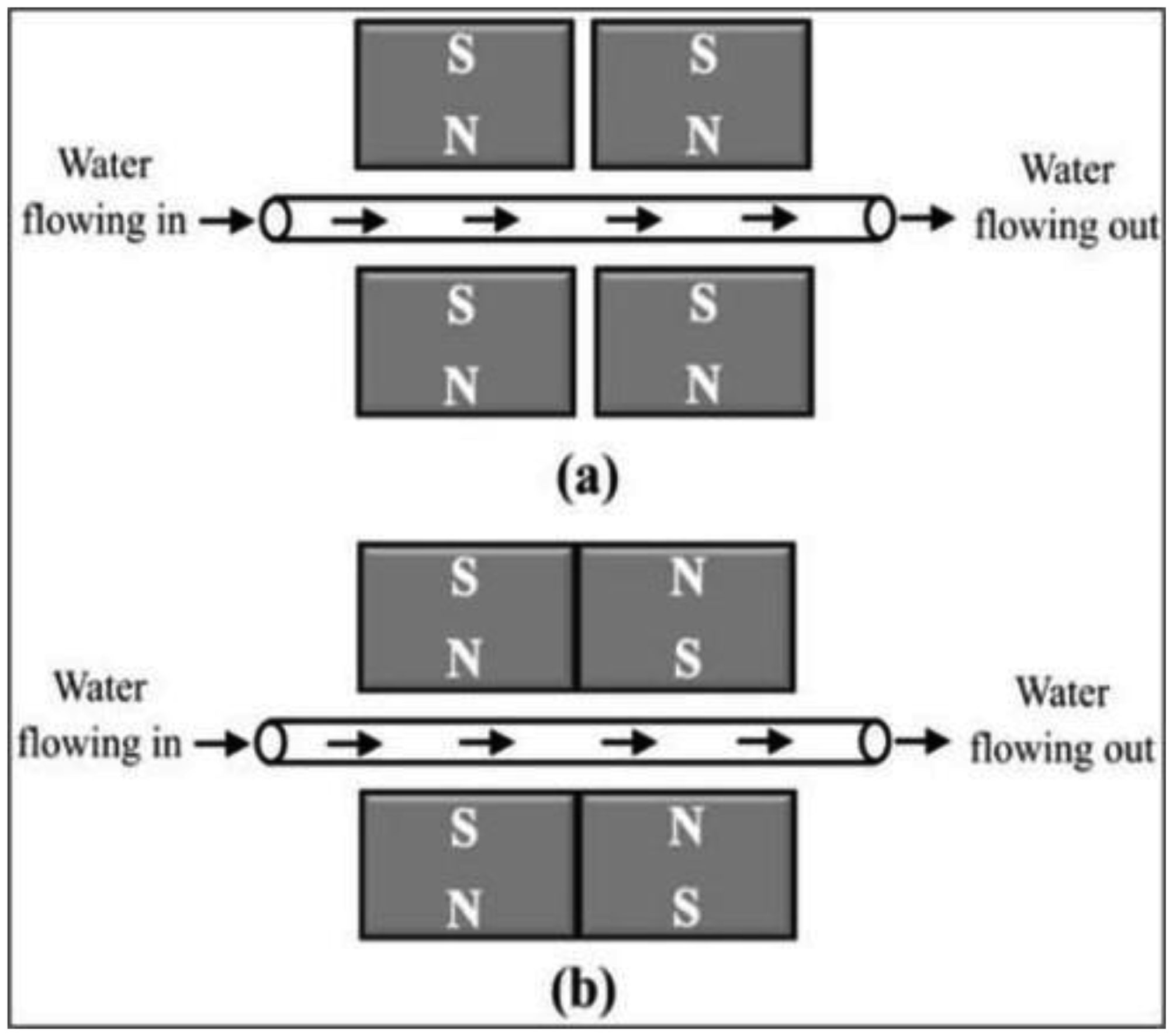









 DownLoad:
DownLoad:





